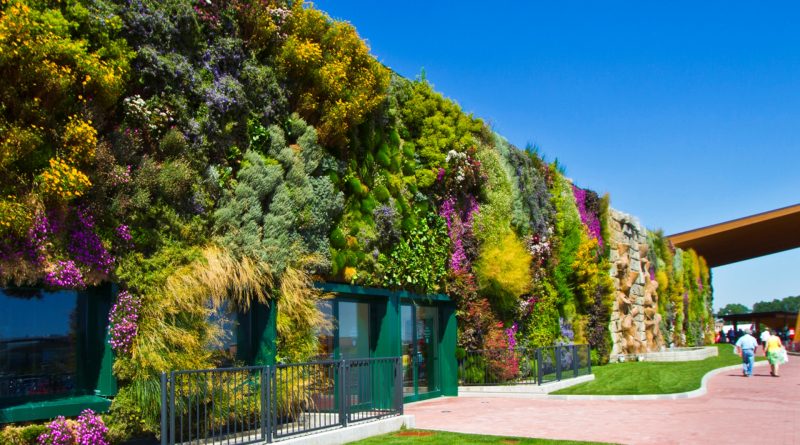Vertical garden
Vertical garden
The term vertical garden defines a vertical realization implanted with specific plant species.
The plants are rooted in compartments between two layers of fibrous material anchored to the wall and, moreover, to guarantee the water supply, a special plant is provided between the layers.
Today, green walls are a form of agriculture or urban landscape. Often conceived as a work of art due to their beauty.
These works are often carried out in cities, especially on the vertical surfaces of buildings.
The vertical garden, in addition to being a distinctive element of green architecture, brings with it some advantages, constituting a “second skin” of the buildings:
– improvement of the thermal insulation of buildings, avoiding direct solar radiation on the wall, which does not heat up and does not radiate heat inside;
– improvement of the aesthetic impact of the building, also in comparison with the surrounding buildings;
– helps to capture fine dust (PM10) in an urban environment;
– possible integration of economic activities.
History of vertical gardens –
The pioneer of the construction of the vertical garden was Patrick Blanc, a Parisian botanist and scholar who with his spectacular vertical gardens has covered facades and areas, both public and private, not only in the French capital.
He built the first wall at the museum of La Villette, in Paris. Then 15,000 square meters in Rue d ‘Alsace, and finally the green facade of the Quai Branly museum, for which he has become famous.
Over time, other green designers (such as agronomists and architects) have indulged themselves around the world with increasingly refined plant walls.
Technique –
Vertical gardens are harmonious compositions of plants made on stratified panels or modules (PVC and felt) inserted in a metal cage, which is fixed to the walls (external vertical gardens) or to the walls (internal vertical gardens), but can also be supported by special structures.
The cultivation method is an integrated system that allows a constant water supply of rainwater and fertilizers, using drip systems placed in the upper part of the wall and there is no need for soil.
There are various types of green walls, all easily adaptable to any architectural surface and modular according to specific needs:
– partial or total cladding of external facades;
– self-supporting walls;
– containment walls;
– fences.
Furthermore, vertical gardens are highly appreciated not only as an aesthetic solution, but also for sound insulation, for purification from atmospheric pollutants and for thermal regulation which also allows energy savings.
To make better use of these suggestions, it is necessary to start from some considerations and assessments on the buildings affected by these operations.
In particular, it should be considered that the facades of buildings can be covered with herbaceous vegetation thanks to the principle that not all plants need land to live. For many species, water, oxygen and carbon dioxide are sufficient, thanks to chlorophyll photosynthesis.
Plant species –
The plant species used for a vertical garden can be chosen based on various factors.
Based on environmental factors, the most suitable herbaceous species can be divided into two macro categories:
Micro-thermal species: particularly suitable for temperatures between 15 and 25 ° C, with less tolerance to heat, drought and salinity, with greater growth in autumn and spring. The following species belong to this group:
– Festuca arundinacea;
– Lolium perenne;
– Poa pratensis;
– Festuca rubra.
Macrothermal species: suitable for warmer climates and therefore not very suitable for those where temperatures can drop below 0 °. In this case they lose their green color and go into vegetative rest. The optimal growth temperature is between 25 and 35 ° C. The following species belong to this group:
– Cynodon dactylon;
– Paspalum vaginatum;
– Stenotaphrum secundatum;
– Zoysie spp.
Advantages of using a vertical garden –
The design of a vegetable garden is normally carried out to mitigate the excessive impact of anthropization on the natural ecological system.
Thus the facades covered with vertical lawns offer some advantages:
– air purification through the absorption of carbon dioxide and the production of oxygen;
– thermal regulation. The transpiration of the plants cools the air and the cavity promotes air circulation;
– filtering and purification of atmospheric pollutants;
– noise reduction and reverberation reduction. The vegetable mass absorbs sound and light waves;
– obstacle to the spread of fire;
– enhancement of buildings and psychological benefits;
– increase of possible microhabitats for particular animal species.

